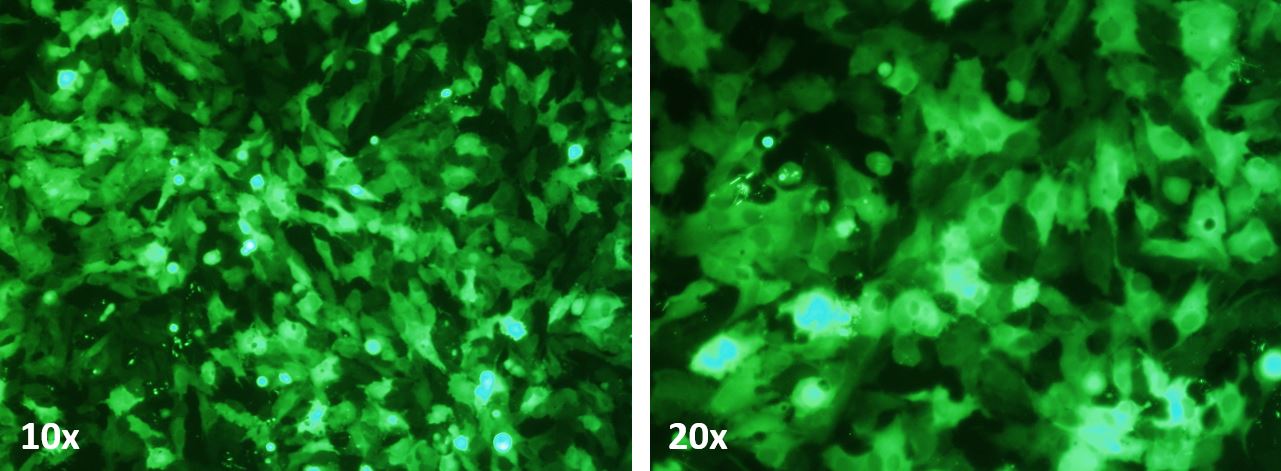Description
Cells to transfect:
Cell Line Name: MCF7 (ATCC® HTB-22®)
Cell Synonyms: ATCC® HTB-22®, NCI60, NCI-60
Organism: Homo sapiens, human
Tissue: mammary gland; breast: pleural effusion
Cell Type: epithelial
Morphology: epithelial
Culture Properties: adherent
Disease: adenocarcinoma
Age: 69 years adult
Gender : female
Ethnicity: Caucasian
Applications: These cells are suitable as a transfection host.
estrogen receptor, expressed
Genes Expressed: insulin-like growth factor binding proteins (IGFBP) BP-2; BP-4; BP-5,Blood Type O; Rh+
Comments: The MCF7 line retains several characteristics of differentiated mammary epithelium including ability to process estradiol via cytoplasmic estrogen receptors and the capability of forming domes. The cells express the WNT7B oncogene.
MCF7 is one of the cell lines of the NCI-60 panel which represents different cancer types and has been widely utilized for drug screening and molecular target identification.
Transfection reagent features:
- Broad spectrum for the transfection of large plasmid, mRNA, siRNA, and/or other type of nucleic acids, which is best for co-transfection of different type and/or size of nucleic acids.
- Specifically optimized to deliver nucleic acids into MCF7 cells
- Highest efficiency to ensure experimental success
- Extremely gentle to cells
- Much less reagent needed for each transfection: 0.5 ml is able to transfect about 1000 wells of 24-well plate
- Deliver single or multiple plasmids
- Synthesized from 100% animal origin-free components, making it easy to validate the absence of zoonotic diseases, such as BSE or viruses, in research experiments or cells lines
- Compatible with serum
- Suitable for Reverse Transfection
- Compatible with transfection in any plate format
- Developed and manufactured by EZ Biosystems
Data
 FIG. 1. High throughput test of transfection efficiency (determined as RLU/mg) on MCF7 cells after transfection of luciferase reporter gene by using our 172 proprietary transfection formulas and several most popular commercial transfection reagents. The yellow box showed the results of 4 commercial transfection reagents. The red lines marked our candidate formulas with the highest transfection efficiency for MCF7 cells. This test result was confirmed with repeat experiments. The one that showed the optimal balance of potent & low cytotoxicity among those candidate formulas after flow cytometry analysis on the percentage of 7AAD positive cells was later named as this MCF7 Cell Avalanche® Transfection Reagent.
FIG. 1. High throughput test of transfection efficiency (determined as RLU/mg) on MCF7 cells after transfection of luciferase reporter gene by using our 172 proprietary transfection formulas and several most popular commercial transfection reagents. The yellow box showed the results of 4 commercial transfection reagents. The red lines marked our candidate formulas with the highest transfection efficiency for MCF7 cells. This test result was confirmed with repeat experiments. The one that showed the optimal balance of potent & low cytotoxicity among those candidate formulas after flow cytometry analysis on the percentage of 7AAD positive cells was later named as this MCF7 Cell Avalanche® Transfection Reagent.
 FIG. 2. MCF7 cells were transfected with GFP vector (pEGFP-N3) by using MCF7 Cell Avalanche® Transfection Reagent. The cells were visualized by Nikon Eclipse Fluorescence microscope 48 hours post transfection.
FIG. 2. MCF7 cells were transfected with GFP vector (pEGFP-N3) by using MCF7 Cell Avalanche® Transfection Reagent. The cells were visualized by Nikon Eclipse Fluorescence microscope 48 hours post transfection.
For Other Cells
MCF7 Cell Avalanche® Transfection Reagent (human breast carcinoma cell) can also be used on the following cells with high transfection efficiencies.
BT-20 Cell
HCC1937 Cell
Hs-578-T Cell
T47D cell
MDA-MB-468 Cell
SK-BR-3 Cell
MDA-MB-231 Cell
293 Cell
293T/17 Cell
Recommended protocols for these cells will be provided with the reagent. The protocols usually provide satisfactory transfection efficiency with invisible cytotoxicity. However, optimization may be needed for certain type of cells. Optimizations may include: the amount of DNA and this transfection reagent; cell density; transfection reagent/DNA ratio, or incubation time for the mixture of transfection reagent/DNA etc. For best transfection result, we recommend using the respective cell type/cell line specific Avalanche transfection reagents. Those reagents have been optimized on both recipes and protocols, and have been proved to have the best transfection results for the respective cell lines or primary cells. You can easily find the respective Avalanche transfection reagents specific for your cells by using the filters of our product list.
Additional Information
| Weight | 0.5 lbs |
|---|---|
| Adherence Phenotype |
Adherent |
| Cell Type |
Epithelial Cell |
| Disease |
Cancer |
| Names starting from |
M |
| Primary/Cell Line |
Cell Line |
| Product Sizes |
0.5 ml, 1.5 ml |
| Species |
Human |
| Tissue Sources |
Breast/Mammary |
| Subcategories |
Cell Type/Cell Line Specific |
Documents
Protocols
MSDS
Citations or Feedback


